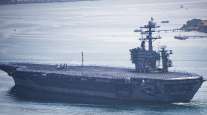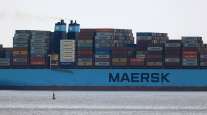Big Emissions Bills Are Coming for Ships Sailing in Europe

[Stay on top of transportation news: Get TTNews in your inbox.]
Ships carrying everything from consumer goods to food and fuel in and out of the European Union will soon face hefty emissions bills.
The maritime industry will join the bloc’s Emissions Trading System in January, meaning big ships will start paying for carbon emissions. Some major freight firms — such as MSC Mediterranean Shipping Co. SA and A.P. Moller-Maersk A/S — could see costs run into hundreds of millions of dollars, according to BloombergNEF.
Maersk ranks No. 5 on the Transport Topics Top 50 list of the largest global freight companies.
Vessels carry more than 80% of world trade and are a big source of emissions, pumping about 1 billion tons of CO2 into the atmosphere in 2018. The incoming system is the world’s first large-scale carbon charge for international shipping and part of the bloc’s green push to tackle climate change. Though sizable, the fees are unlikely to be high enough to force an immediate shift to cleaner marine fuels.

Longva
“The EU ETS will increase the freight rates,” said Tore Longva, decarbonization director at ship classification society DNV. But vessel supply and demand is likely to have a bigger impact on shipping rates, he said.
For a single containership sailing between Europe and Asia, the emissions cost could total about 810,000 euros ($864,500) next year, according to DNV. Firms will have to cover a greater share of emissions in the following two years, meaning costs should go even higher.
An example of how it will work: A vessel carrying 5,000 standard-sized containers between the EU and Asia over a year generates about 40,000 tons of CO2. But because the journeys stretch outside Europe, only half the emissions need to be covered.
That means incurring a cost for 20,000 tons of CO2, plus an extra 2,500 tons while the ship is in European ports.
In the first year, 40% of the qualifying emissions are chargeable, so that ship would face costs for 9,000 tons of CO2.
Assuming a carbon price of 90 euros a ton, that’s €810,000 euros.
That would rise to 1.4 million in 2025 when 70% of emissions must be covered and 2 million in 2026 when all emissions are chargeable (assuming a 90-euro carbon price).
The regulation covers ships of 5,000 gross tonnage and above and applies to vessels going into — and out of — EU and European Economic Area ports.
It could take a while for the program to really cut emissions, though. At a carbon price of about €90 euros, it would still be cheaper to use polluting oil-based fuels and pay for the emissions rather than use more expensive marine biofuels, Longva said.
And while the additional costs are notable, shippers have seen big swings in fuel prices in recent years that far outstripped the looming carbon charges.

Gragg Wilson of UPS won grand champion honors at the National Truck Driving Championships. Wilson takes us through the competition's course, successful driving practices and how to attract new drivers. Tune in above or by going to RoadSigns.ttnews.com.
For example, a carbon price of €90 euros would equal a charge of less than 300 euros for every ton burned of oil-based fuel. Yet the cost of very low-sulfur fuel oil in Rotterdam — a common propellant — jumped by about $850 a ton in less than two years through early 2022.
Still, the emissions system will encourage shippers to be more fuel efficient. And as the number of allowances available to buy to cover emissions falls, that should push up carbon prices and make the system more effective. Emissions of methane and nitrous oxide from shipping will also be included in years to come.
The EU also has a separate regulation coming into force in 2025 called the FuelEU Maritime, which should also drive shippers toward cleaner fuels. It sets maximum limits on the annual greenhouse gas intensity of the energy used by vessels, with the targets getting tougher as time passes.
— With assistance from Ewa Krukowska.




